Whatever your business, competition is inevitable. There’s always going to be someone out there, doing something very similar. Customers are often overwhelmed with options, and they want to understand what makes your product better than everyone else’s. This is why all businesses need to identify their unique selling point (USP) to help build your brand image.
However, it’s all well and good identifying your USP, but it’s also equally as important to understand which USP’s actually convert into sales. And thankfully for you, we’re here to identify them. We’ve put together some examples of great USP’s that have been used by brands all over the world, to hopefully inspire you to when taking your next business venture.
- Customer Loyalty
As a business, you want to show customers that you have their best interests at heart, and that is exactly what AVIS did in 1962. For many years, AVIS landed in second place to Hertz when it came to car renting in the USA, until they hired Doyle Dane Bernbach who turned being number two into the best argument for better service. Their USP was the ideas that because they were not yet number 1, they absolutely must put their customers first to get to that top spot. And boy, did it work. Avis’ market share grew from 29% to 36%. Take a look at some of their genius ads below.
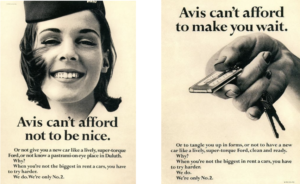
(Source: www.dailycitizen.news)
- Play on pain points
Making your brand stand out from its competitors is always super important and one way to do this, is to play on customer pain points. Now, we’re not telling you to bash every one of your competitors, but if you can playfully hint at your competitors’ downfalls, go for it. M&M tried their hand in this technique in the 1980’s. They introduced the clever, yet playful slogan “The chocolate that melts in your mouth, not your hands”. Now, as all chocolate lovers will know, chocolate melting before it’s even reached your mouth is a big no-no, so M&M’s chocolate coated shell brought an end to this. This slogan highlighted their products versatility whilst also covertly bashing other chocolate brands. It made their chocolate superior, playing on customers pain points and as a result saw sales skyrocket. So, the next time you’re thinking of a USP, always refer back to customer pain points. How can your product solve these issues in ways your competitors can’t?
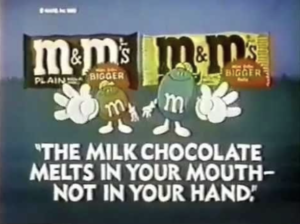
(Source: www.pinterest.co.uk)
- Customer Guarantee
As customers, we like to be promised the world, but for most brands this isn’t possible. However, if you introduce a realistic customer guarantee and use this as your USP in the right way, you can benefit immensely. Domino’s Pizza did exactly this in the 1990’s, when they guaranteed that pizza would be at your door in 30 minutes, and if not, it would be absolutely free. Although this guarantee has since been dropped, when it was live, it worked wonders for them. The concept of a possibly free pizza enticed many customers and as a result, drove their sales massively. This is a very good example of using a guarantee to bring in customers, and if you can do something similar, you will be well on the way to creating a very strong USP.
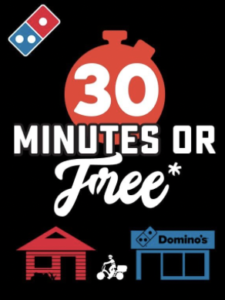
(Source: www.dominos.com.au)
- Relatability
A really strong USP takes into account inclusivity. Most of the time, you want your brand to relate to a wide audience. Excluding certain genders, races, and ages normally isn’t the way forward. Fenty beauty used inclusivity as their USP when launching in late 2017 and created ‘beauty for all’. Founder, Rihanna was very clear from the start that her vision excluded absolutely nobody. She launched with forty shades of foundation, which was astonishing at the time considering usually brands only launch with seven to ten. Today, she has released 50. This inclusivity lead to the brand being named one of the ‘best inventions’ of 2017 by Times Magazine. The brand became available and relatable to women everywhere around the world, and I think we all can learn something from this specific USP.
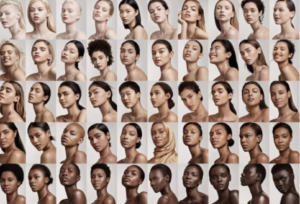
(Source: www.thinkwithgoogle.com)
- Affordability and Simplicity
In today’s climate, people are always looking to save money where they can, which is why affordability is always a good USP to go for. The biggest mistake to avoid here is to brand your product as the cheapest around, as you’re essentially starting a race to the bottom, which you don’t want to do. It can eliminate a lot of value and credibility from your brand. However, when marketed correctly, it can be a very powerful tool. For example, Dollar Shave Club. You’ve probably heard of them before because they ran an extremely strong marketing campaign upon launching. Razor blades are a product that have been around forever, and you’d think would be very hard to market uniquely unless you were to reinvent the whole thing, right? WRONG. Dollar Shave Club took a completely different approach and marketed the traditional razor but focused on simplicity and affordability. Their shaving packages are completely affordable, and magically arrive on your door step the next day – what more could you need? No other brand in the shaving market tried this approach. Whilst they focused on appearance and blade technology, Dollar Shave Club offered the very opposite. Less blades and less tech. So, it’s important to remember that sometimes, less is more when it comes to your USP.
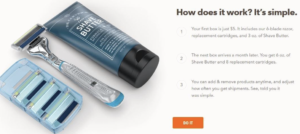
(Source: www.coolerinsights.com)
So, there you have it, the USP’s that actually convert into sales. Still looking for some help with your USP and want to get your brand kickstarted? Book a call with us today and find out how our expert team can help you create a truly unique USP.
